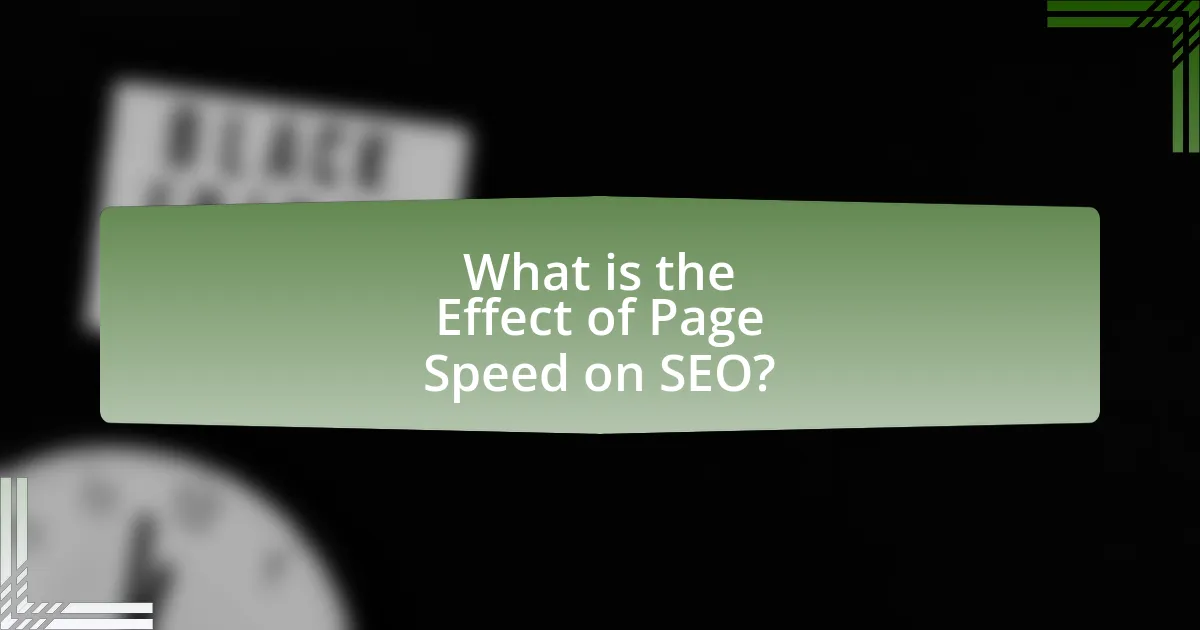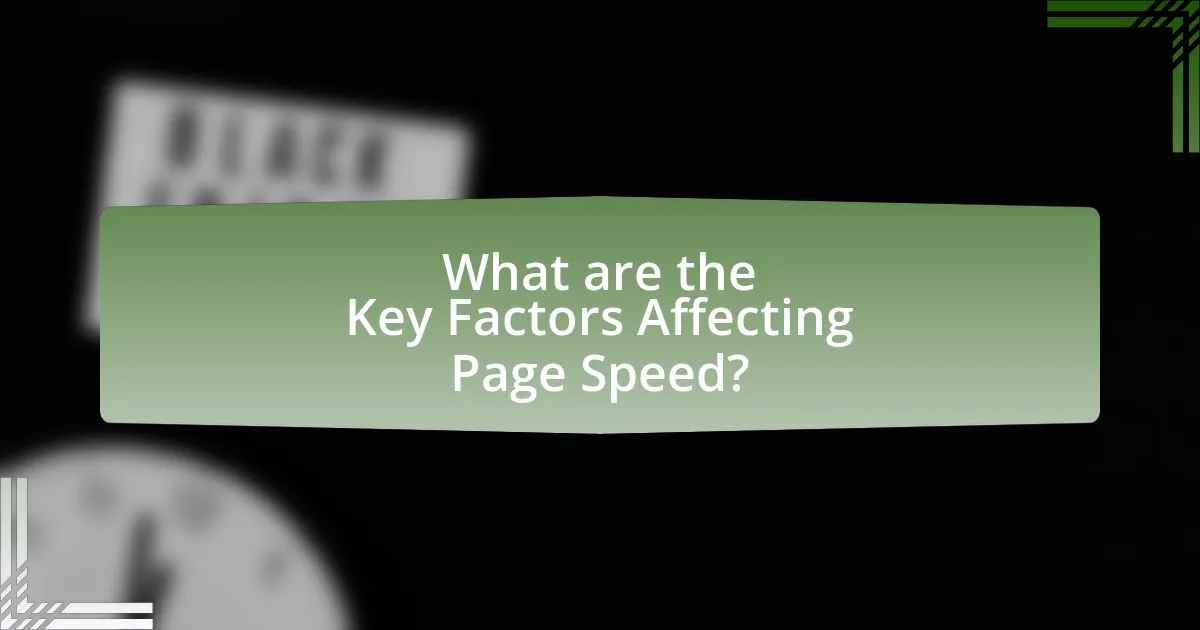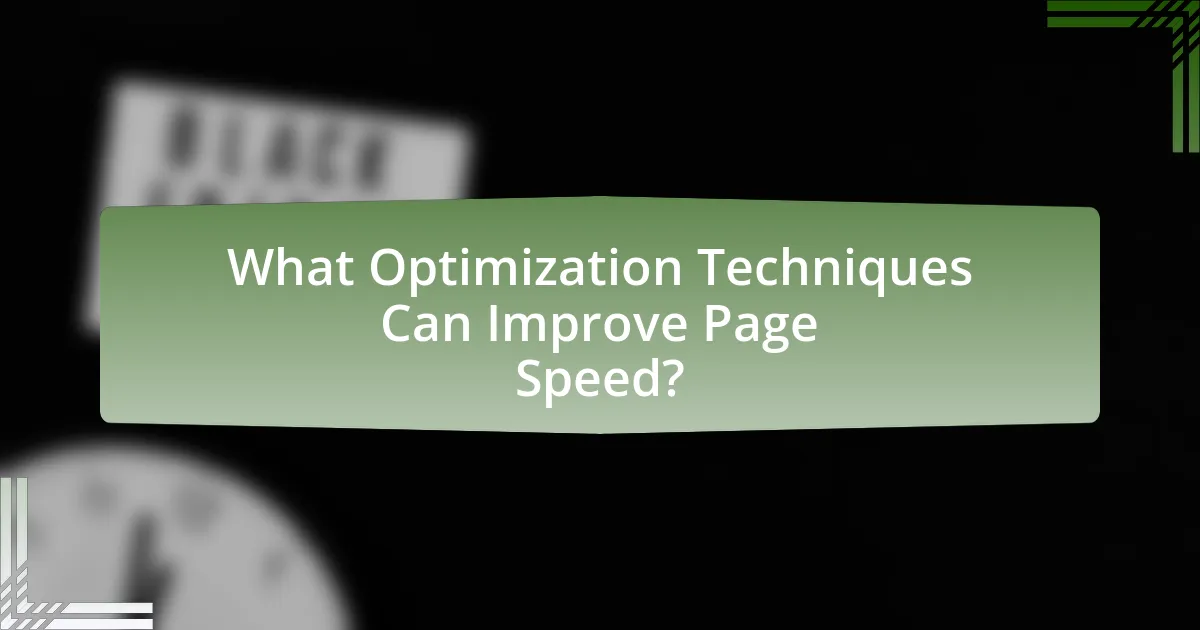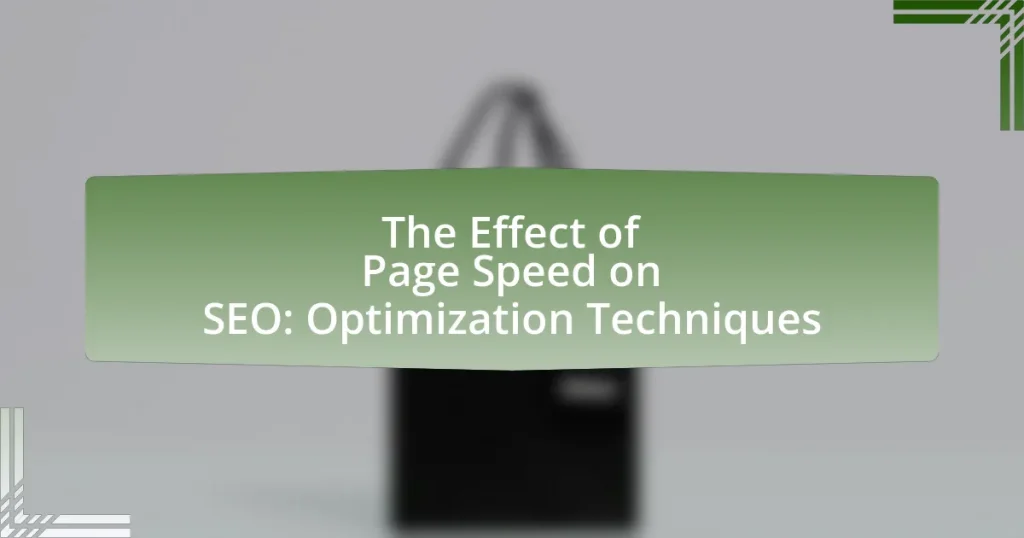The article focuses on the significant impact of page speed on search engine optimization (SEO) and user experience. It outlines how faster-loading pages lead to lower bounce rates and higher engagement, which are critical for search engine rankings, particularly on mobile devices. Key metrics for measuring page speed, such as Time to First Byte and Largest Contentful Paint, are discussed, along with optimization techniques including image compression, code minification, and leveraging browser caching. The article emphasizes the importance of maintaining optimal page speed to enhance user satisfaction and improve visibility in search results, while also addressing common pitfalls and best practices for ongoing performance monitoring.

What is the Effect of Page Speed on SEO?
Page speed significantly impacts SEO by influencing user experience and search engine rankings. Faster-loading pages lead to lower bounce rates and higher engagement, which are critical factors for search engines like Google when determining page quality. Research by Google indicates that a one-second delay in mobile page load time can reduce conversions by up to 20%. Additionally, Google uses page speed as a ranking factor in its algorithms, meaning that slower pages may rank lower in search results, ultimately affecting visibility and traffic.
How does page speed influence search engine rankings?
Page speed significantly influences search engine rankings, as faster-loading pages provide a better user experience, leading to higher engagement and lower bounce rates. Google has confirmed that page speed is a ranking factor, particularly for mobile searches, where slow-loading sites can negatively impact visibility in search results. According to a study by Google, a one-second delay in mobile load times can result in a 20% drop in conversion rates, highlighting the importance of speed in retaining users and improving site performance.
What metrics are used to measure page speed?
The primary metrics used to measure page speed include Time to First Byte (TTFB), First Contentful Paint (FCP), Largest Contentful Paint (LCP), and Total Blocking Time (TBT). TTFB measures the time taken for the server to respond to a request, while FCP indicates the time it takes for the first piece of content to appear on the screen. LCP measures the time it takes for the largest content element to load, and TBT assesses the amount of time that a page is blocked from responding to user input. These metrics are crucial for understanding user experience and optimizing website performance, as they directly impact how quickly users can interact with a webpage.
How do search engines evaluate page speed?
Search engines evaluate page speed primarily through metrics such as Time to First Byte (TTFB), First Contentful Paint (FCP), and Largest Contentful Paint (LCP). These metrics measure how quickly a page responds to requests and how fast content is rendered to users. For instance, Google uses these metrics as part of its Core Web Vitals, which are essential for ranking websites. Research indicates that a one-second delay in page load time can lead to a 7% reduction in conversions, highlighting the importance of speed in user experience and SEO performance.
Why is page speed important for user experience?
Page speed is crucial for user experience because it directly impacts how quickly users can access content on a website. Research indicates that a one-second delay in page load time can lead to a 7% reduction in conversions, highlighting the importance of speed in retaining user attention and encouraging engagement. Additionally, Google has reported that 53% of mobile site visitors abandon a page that takes longer than three seconds to load, demonstrating that faster pages lead to lower bounce rates and higher user satisfaction. Therefore, optimizing page speed is essential for enhancing user experience and improving overall website performance.
How does slow page speed affect user engagement?
Slow page speed negatively impacts user engagement by increasing bounce rates and reducing the time users spend on a site. Research indicates that a one-second delay in page load time can lead to a 7% reduction in conversions, as users are less likely to wait for slow-loading pages. Additionally, Google found that 53% of mobile users abandon sites that take longer than three seconds to load, highlighting the direct correlation between page speed and user retention. Consequently, slower page speeds diminish overall user satisfaction and engagement levels.
What are the consequences of high bounce rates related to page speed?
High bounce rates related to page speed can lead to decreased user engagement and lower search engine rankings. When a webpage takes too long to load, users are more likely to leave before interacting with the content, resulting in a higher bounce rate. Research indicates that a one-second delay in page load time can lead to a 7% reduction in conversions, highlighting the direct impact of speed on user behavior. Additionally, search engines like Google consider bounce rates as a ranking factor; higher bounce rates can signal to search engines that the content may not be relevant or engaging, potentially lowering the page’s visibility in search results.

What are the Key Factors Affecting Page Speed?
The key factors affecting page speed include server response time, file sizes, image optimization, and the use of caching. Server response time impacts how quickly a server can process requests; for instance, a response time of under 200 milliseconds is ideal for optimal performance. Large file sizes can slow down loading times, with studies indicating that reducing file sizes by 50% can significantly enhance speed. Image optimization, such as using the correct format and compression, can reduce load times by up to 80%. Lastly, effective caching strategies can decrease load times by storing frequently accessed data, allowing for quicker retrieval. These factors collectively influence page speed, which is crucial for user experience and SEO rankings.
How do server response times impact page speed?
Server response times directly impact page speed by determining how quickly a server can process requests and deliver content to users. When server response times are slow, it delays the loading of web pages, leading to longer wait times for users. Research indicates that a one-second delay in server response time can lead to a 7% reduction in conversions, highlighting the critical relationship between server performance and user experience. Additionally, Google has stated that page speed is a ranking factor, meaning slower server response times can negatively affect a website’s SEO performance.
What role does hosting quality play in server response times?
Hosting quality significantly impacts server response times by determining the speed and reliability of the server infrastructure. High-quality hosting services utilize advanced hardware, optimized software, and efficient network configurations, which collectively reduce latency and enhance data processing speeds. For instance, a study by Google found that a delay of just 100 milliseconds can decrease conversion rates by 7%, highlighting the critical nature of fast server responses in user experience and SEO performance. Therefore, investing in quality hosting directly correlates with improved server response times, which is essential for maintaining optimal page speed and overall website effectiveness.
How can server configurations optimize page speed?
Server configurations can optimize page speed by enabling features such as caching, compression, and HTTP/2 support. Caching reduces the time taken to retrieve frequently accessed data, while compression minimizes the size of files sent over the network, leading to faster load times. Implementing HTTP/2 allows multiple requests to be sent simultaneously over a single connection, further enhancing speed. According to Google, a one-second delay in page load time can lead to a 20% decrease in conversions, highlighting the importance of optimized server configurations for improving user experience and SEO performance.
What impact do images and media have on page speed?
Images and media significantly impact page speed by increasing load times due to their file sizes and the number of requests made to the server. Large images can slow down a webpage, as they require more bandwidth and processing power to load. For instance, a study by Google found that as page load time increases from one second to five seconds, the probability of a user bouncing increases by 90%. Additionally, unoptimized media can lead to excessive HTTP requests, further delaying page rendering. Therefore, optimizing images and media is crucial for maintaining fast page speed, which directly influences user experience and SEO rankings.
How can image optimization techniques improve loading times?
Image optimization techniques can significantly improve loading times by reducing the file size of images without compromising quality. When images are optimized, they consume less bandwidth and load faster, which enhances user experience and decreases bounce rates. For instance, using formats like WebP can reduce image sizes by up to 30% compared to traditional formats like JPEG and PNG. Additionally, implementing responsive images ensures that the appropriate image size is served based on the user’s device, further improving loading efficiency. Studies have shown that a 1-second delay in page load time can lead to a 7% reduction in conversions, highlighting the importance of image optimization in maintaining site performance and SEO rankings.
What formats are best for web images to enhance speed?
The best formats for web images to enhance speed are WebP, JPEG, and PNG. WebP offers superior compression, reducing file sizes significantly while maintaining quality, which can lead to faster loading times. JPEG is widely used for photographs due to its efficient compression, balancing quality and file size. PNG is ideal for images requiring transparency and lossless compression, though it typically results in larger file sizes compared to JPEG. According to Google, using WebP can reduce image sizes by up to 30% compared to JPEG and PNG, thereby improving page speed and overall SEO performance.

What Optimization Techniques Can Improve Page Speed?
Optimization techniques that can improve page speed include image compression, minification of CSS and JavaScript, leveraging browser caching, and using a Content Delivery Network (CDN). Image compression reduces file sizes without significant loss of quality, which can decrease load times. Minification of CSS and JavaScript removes unnecessary characters, leading to smaller file sizes and faster downloads. Leveraging browser caching allows frequently accessed resources to be stored locally on a user’s device, reducing the need for repeated downloads. Utilizing a CDN distributes content across multiple servers worldwide, decreasing the distance data must travel to reach users, thus enhancing load speed. These techniques are supported by studies indicating that faster page speeds correlate with improved user experience and higher search engine rankings.
How can caching improve page speed?
Caching can significantly improve page speed by storing frequently accessed data temporarily, allowing for quicker retrieval on subsequent requests. When a user visits a webpage, caching saves elements such as images, scripts, and HTML files, reducing the need to fetch these resources from the server each time. This leads to faster load times, as data is served from the cache rather than being generated anew. Studies show that effective caching can reduce page load times by up to 80%, enhancing user experience and positively impacting SEO rankings.
What types of caching are most effective for websites?
The most effective types of caching for websites include browser caching, server-side caching, and content delivery network (CDN) caching. Browser caching stores static resources like images and scripts on a user’s device, reducing load times for repeat visits. Server-side caching, such as object caching and page caching, minimizes database queries and speeds up content delivery by storing pre-rendered pages or data. CDN caching distributes content across multiple servers globally, allowing users to access data from the nearest location, which significantly enhances loading speed. Studies show that implementing these caching strategies can improve website performance and positively impact SEO rankings by reducing page load times, which is a critical factor in search engine algorithms.
How do browser caching settings affect user experience?
Browser caching settings significantly enhance user experience by reducing page load times. When a browser caches resources such as images, scripts, and stylesheets, it stores them locally, allowing for quicker retrieval on subsequent visits. This leads to faster page rendering, which is crucial as studies show that a one-second delay in page load time can lead to a 7% reduction in conversions. Additionally, effective caching minimizes server load and bandwidth usage, further improving performance. Therefore, optimized browser caching settings directly contribute to a smoother and more efficient user experience.
What role does code minification play in page speed optimization?
Code minification plays a crucial role in page speed optimization by reducing the size of code files, which leads to faster loading times. When HTML, CSS, and JavaScript files are minified, unnecessary characters such as whitespace, comments, and line breaks are removed, resulting in smaller file sizes. This reduction in size decreases the amount of data that needs to be transferred over the network, thereby improving the time it takes for a webpage to load. Studies have shown that faster loading times can significantly enhance user experience and positively impact search engine rankings, as Google considers page speed as a ranking factor.
How can HTML, CSS, and JavaScript be minified effectively?
HTML, CSS, and JavaScript can be minified effectively by removing unnecessary characters, such as whitespace, comments, and line breaks, without affecting functionality. Tools like UglifyJS for JavaScript, CSSNano for CSS, and HTMLMinifier for HTML automate this process, ensuring that the code is compact and optimized for faster loading times. According to Google, reducing file sizes can significantly improve page speed, which is a critical factor in SEO rankings.
What tools are available for code minification?
Tools available for code minification include UglifyJS, Terser, Google Closure Compiler, and CSSNano. UglifyJS is widely used for JavaScript minification, effectively reducing file size while maintaining functionality. Terser is a modern alternative to UglifyJS, offering ES6+ support and better performance. Google Closure Compiler provides advanced optimizations and can also be used for JavaScript minification. CSSNano is specifically designed for CSS minification, optimizing stylesheets for faster loading times. These tools are essential for improving page speed, which directly impacts SEO performance.
How can Content Delivery Networks (CDNs) enhance page speed?
Content Delivery Networks (CDNs) enhance page speed by distributing content across multiple geographically dispersed servers, allowing users to access data from the nearest server. This proximity reduces latency and load times, as data travels shorter distances. For instance, a study by Akamai found that a 100-millisecond delay in load time can decrease conversion rates by 7%. By caching static content and optimizing delivery routes, CDNs can significantly improve the speed at which web pages load, directly impacting user experience and SEO rankings.
What are the benefits of using a CDN for website performance?
Using a Content Delivery Network (CDN) significantly enhances website performance by reducing latency and improving load times. CDNs achieve this by distributing content across multiple geographically dispersed servers, allowing users to access data from a server closest to their location. This proximity minimizes the distance data must travel, resulting in faster delivery speeds.
Research indicates that websites utilizing CDNs can experience load time reductions of up to 50%, which directly correlates with improved user experience and engagement. Additionally, faster load times positively impact search engine rankings, as page speed is a critical factor in SEO algorithms. For instance, Google has stated that a one-second delay in mobile load times can lead to a 20% decrease in conversion rates. Therefore, implementing a CDN not only optimizes website performance but also enhances SEO outcomes.
How do CDNs work to reduce latency?
Content Delivery Networks (CDNs) reduce latency by distributing content across multiple geographically dispersed servers. This architecture allows users to access data from a server that is physically closer to them, minimizing the distance data must travel and thus decreasing load times. For example, when a user requests a webpage, the CDN directs the request to the nearest server, which can deliver the content more quickly than a centralized server located far away. Studies have shown that using CDNs can improve page load times by up to 50%, significantly enhancing user experience and positively impacting SEO rankings.
What are some common pitfalls to avoid in page speed optimization?
Common pitfalls to avoid in page speed optimization include neglecting image optimization, failing to leverage browser caching, and not minimizing HTTP requests. Neglecting image optimization can lead to large file sizes, which slow down loading times; for instance, unoptimized images can increase page load time by up to 80%. Failing to leverage browser caching prevents returning visitors from loading pages quickly, as they must download all resources again. Not minimizing HTTP requests can also significantly impact speed; each request adds latency, and reducing them can improve load times by up to 50%. Addressing these pitfalls is crucial for enhancing page speed and, consequently, SEO performance.
How can excessive plugins slow down a website?
Excessive plugins can slow down a website by increasing the number of HTTP requests and consuming server resources. Each plugin typically requires its own scripts, styles, and database queries, which collectively add to the loading time. Research indicates that websites with more than 20 plugins can experience significant performance degradation, as each additional plugin can increase page load time by an average of 1-2 seconds. This delay negatively impacts user experience and can lead to higher bounce rates, ultimately affecting search engine rankings.
What are the risks of neglecting mobile optimization?
Neglecting mobile optimization poses significant risks, including decreased user engagement and higher bounce rates. Research indicates that 53% of mobile users abandon sites that take longer than three seconds to load, which directly impacts user retention and satisfaction. Additionally, search engines like Google prioritize mobile-friendly websites in their rankings; thus, failure to optimize for mobile can lead to lower visibility in search results. This diminished visibility can result in reduced traffic and potential revenue loss, as businesses miss out on the growing number of consumers who primarily use mobile devices for online browsing and shopping.
What are the best practices for maintaining optimal page speed?
To maintain optimal page speed, implement techniques such as image optimization, minification of CSS and JavaScript, and leveraging browser caching. Image optimization reduces file sizes without sacrificing quality, which can significantly decrease load times; for instance, using formats like WebP can reduce image sizes by up to 30% compared to traditional formats. Minification of CSS and JavaScript removes unnecessary characters, leading to faster parsing and execution, which can improve load times by 10-20%. Leveraging browser caching allows frequently accessed resources to be stored locally on users’ devices, reducing server requests and speeding up page load times. According to Google, a one-second delay in mobile load times can reduce conversions by up to 20%, highlighting the importance of these practices for both user experience and SEO.
How often should page speed be tested and monitored?
Page speed should be tested and monitored at least once a month. Regular monthly testing allows website owners to identify performance issues and implement necessary optimizations in a timely manner. Additionally, significant changes to the website, such as new content, design updates, or added features, should trigger immediate testing to ensure that these modifications do not negatively impact loading times. Consistent monitoring helps maintain optimal performance, which is crucial for SEO, as search engines prioritize fast-loading pages in their rankings.
What tools can help track and analyze page speed performance?
Google PageSpeed Insights is a tool that helps track and analyze page speed performance. It provides detailed insights into how well a webpage performs on both mobile and desktop devices, offering suggestions for improvement based on real-world data. Additionally, GTmetrix is another effective tool that combines Google Lighthouse and WebPageTest to analyze page speed, providing a comprehensive report on various performance metrics. Furthermore, Pingdom offers a user-friendly interface to monitor page speed and performance, allowing users to test from different locations globally. These tools are widely recognized in the industry for their accuracy and reliability in assessing page speed performance.




